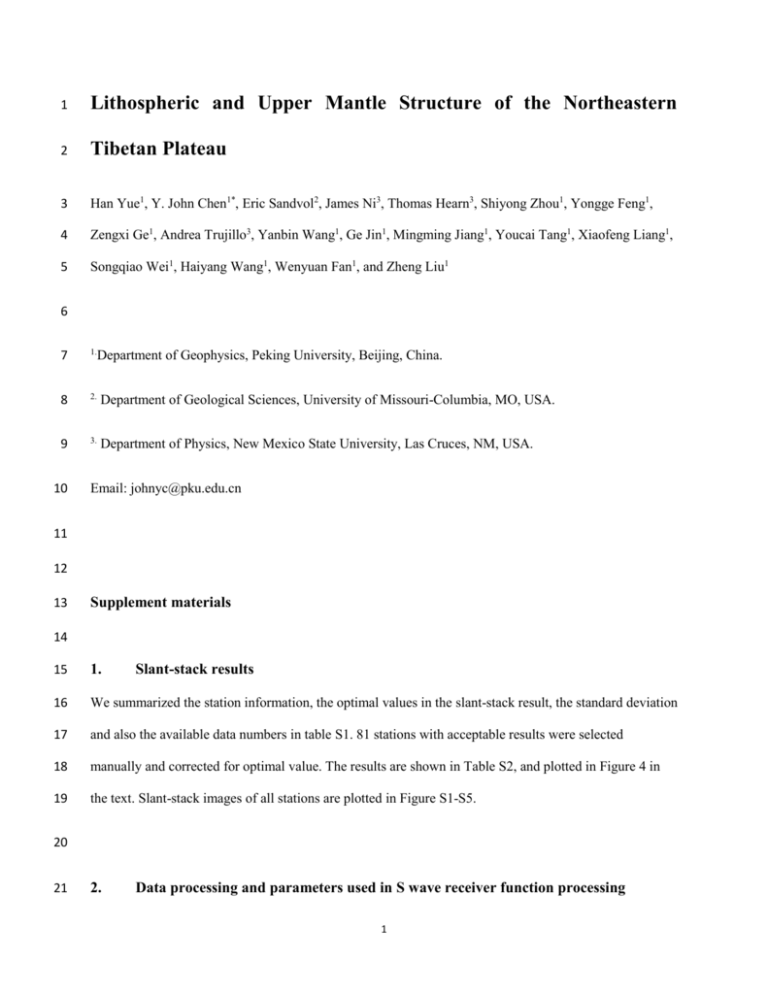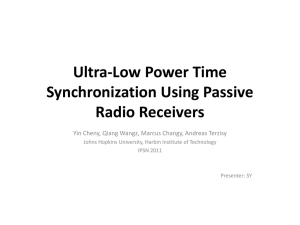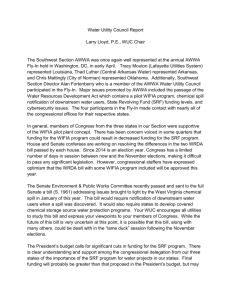jgrb16985-sup-0002-txts01
advertisement

1 Lithospheric and Upper Mantle Structure of the Northeastern 2 Tibetan Plateau 3 Han Yue1, Y. John Chen1*, Eric Sandvol2, James Ni3, Thomas Hearn3, Shiyong Zhou1, Yongge Feng1, 4 Zengxi Ge1, Andrea Trujillo3, Yanbin Wang1, Ge Jin1, Mingming Jiang1, Youcai Tang1, Xiaofeng Liang1, 5 Songqiao Wei1, Haiyang Wang1, Wenyuan Fan1, and Zheng Liu1 6 7 1. 8 2. Department of Geological Sciences, University of Missouri-Columbia, MO, USA. 9 3. Department of Physics, New Mexico State University, Las Cruces, NM, USA. 10 Department of Geophysics, Peking University, Beijing, China. Email: johnyc@pku.edu.cn 11 12 13 Supplement materials 14 15 1. 16 We summarized the station information, the optimal values in the slant-stack result, the standard deviation 17 and also the available data numbers in table S1. 81 stations with acceptable results were selected 18 manually and corrected for optimal value. The results are shown in Table S2, and plotted in Figure 4 in 19 the text. Slant-stack images of all stations are plotted in Figure S1-S5. Slant-stack results 20 21 2. Data processing and parameters used in S wave receiver function processing 1 22 23 Here we present more details about the S wave receiver function processing. 1. S wave receiver function calculation 24 25 The raw seismograms are cut using a time window of about 20s to 40s with reference to the 26 theoretical S wave arrival time. The vertical and radial components are then rotated to the Sv and S 27 components using the theoretical ray parameters. Subsequently we remove the mean value and linear 28 trend from the data and then apply a two pass fourth order tapered bandpass filter with a corner frequency 29 between 0.001 and 1 Hz. In order to make the S-wave receiver functions directly comparable with the P- 30 wave receiver functions, we reverse the sense of time since the Sp phases arrive prior to the primary 31 teleseismic phase. After this step we perform , a time domain deconvolution procedure with a 1.5 Hz 32 Gaussian filter to obtain. 33 34 35 2. SRF CCP stacking In order to stack SRFs by their common conversion points, we first interpolate 1D velocity models 36 from the CUB 2.0 model for each station, we then calculate the piercing point location and arrival time 37 difference between S and Sp waves at each depth (0~250 km) for each record. Since the plane wave 38 assumption is not applicable in calculating the SRFs for deeper conversions, we need to calculate the ray 39 parameters for each source-converter-receiver set. This information is used to trace the Sp ray paths to 40 obtain the piercing points from different conversion depths. The theoretical ray parameters are calculated 41 using a global 1D velocity model, AK135 model [Kenneth et al. 1995]. We assign all SRF amplitudes to 42 their appropriate bin in depth and along the profile according to their ray path; all SRF amplitudes in a 43 common bin are then stacked. When stacking the SRFs in our designated profiles, we make profiles 44 following the station distribution on the surface, and the profiles are dipped toward the east so that they 45 are parallel to the predominant raypath direction. Bin size is adjusted at various depths to keep a relatively 2 46 constant number of stacking bins. The equation used for stacking all SRF amplitudes in all bins is given 47 by the following expression: G G (| x j xi |, z ) 48 Aj ( z ) Ai ( z ) i (S1) (| x j xi |, z ) i 49 In equation S1, Aj(z) stands for the stacked SRF amplitude of the jth stacking bin at depth z. G(|Xj-Xi|,z) 50 is the stacking weight at each depth which is calculated by the distance between the jth stacking point and 51 the ith piercing point. Ai(z) is the SRF amplitude of the ith SRF at the depth z. The stacking weight is 52 calculated in the following equation. G(|x j xi |, z ) exp[( 53 54 | x j xi | cdist( z ) )2 ] (S2) |xj-xi| stands for the distance between the jth stacking point and the ith piercing point. The 55 parameter cdist is the the bin size that increases linearly with the depth z. Only the SRFs whose piercing 56 points are included by the critical bin size are used in stacking. It is calculated by cdist=a*z+b, where a 57 and b are two constants controlling the bin size and the increasing rate. The shapes of the bins are shown 58 in both Figure 7 and Figure S6. 59 60 Figure Captions: 61 Figure S1 – S5. Slant-stack and bootstrap results of all I4 and DKL stations; the description of the 62 method can be found in Al-Damegh, et al., (2005). The maximum values of all slant-stack images 63 are plotted as the white star. We manually chose the optimal Moho depth and Vp/Vs ratio by 64 considering the continuity of adjacent stations. Stations in the Qiangtang Terrane (region A in 65 Figure 4) are identified by 65-70 km Moho depth and 1.8 Vp/Vs ratio, including (C08-C14, F16, 3 66 F17). Stations in the Songpan-Ganzi region (Region B in Figure 4), are identified by 70-75 km 67 Moho depth and 1.7 Vp/Vs ratio (station B02 and the rest of the stations in the high plateau south 68 of the Kunlun Mountains). 69 70 Figure S6. SRF CCP stacking result in three EW profiles. Red circles represent the location of each 71 station, blue circles are piercing points of SRF at 150 km depth, and piercing points of SRF at 200 72 km depth are shown by green circles. Brown line marks the boundary of the image with less than 73 20 traces. The red polygon marks where underthrusted Lhasa block lithosphere slab (ULS) is 74 found in the stacked SRFs. ULS and LAB are marked as dash lines in Figure b, c, and d. Gaussian 75 stacking weight functions are shown as a trapezoid with the same scale as the stacking section. 76 77 References: 78 Al-Damegh, K., E. Sandvol, and M. Barazangi (2005), Crustal structure of the Arabian plate: new 79 constraints from the analysis of teleseismic receiver functions, Earth and Planetary Science 80 Letters, 231(3–4), 177-196. 81 82 Kennett, B. L. N., E. R. Engdahl, and R. Buland (1995), Constraints on seismic velocities in the Earth from traveltimes, Geophysical Journal International, 122(1), 108-124. 83 4







